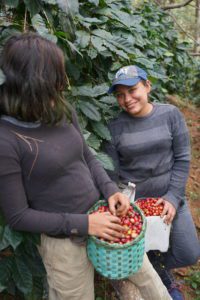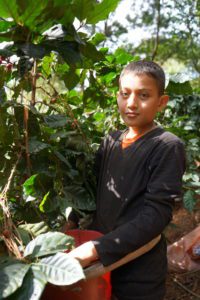Since coffee only grows in certain climates, people who have realized it’s good to trace the origin of the beans must choose which country’s coffee they’ll buy. Honduras is an overlooked country with an interesting history—including being home to the first capital (1544) of Spanish Central America. Along with its unnoticed history, the many delicious coffees it grows haven’t yet received the credit they deserve. Honduras coffee growth is steeped in interesting history with international players.

Honduras is a small country, however, it has so many great qualities that are overlooked when people in North America repeat negative, stereotypical portrayals of Honduras. It has a rich history, from being the southernmost region of the Mayan Empire to having early European contact in the colonial period. The Spanish hunt for gold led them to establish the first capital of Spanish Central America in Western Honduras.
Honduras Coffee
Coffee has been grown in Honduras for a long time, with great taste results. Over 75% of Honduras’s land is mountainous. Although less developed countries’ products don’t often make headlines, there are advantages to the smaller coffee farms that produce coffee and other foods. Much more care can be poured into growing and crafting great coffee when conscientious humans make the decisions instead of machines or indifferent workers. Larger operations and massive profit-driven agribusinesses can take shortcuts that churn out mediocre coffee. Many Honduras coffee farms ensure their beans are grown, maintained and crafted with care.
One mountainous region of Honduras that merits special attention is the western are near El Salvador and Guatemala. In the mountains at over 1,000 meters lie interesting cities and towns—that grow great coffee! In Copán and nearby departments, inhabitants have lived under Mayan and Spanish rule. They now enjoy relative democracy, albeit with sociopolitical and economic challenges. The people maintain a close relationship with the land. Luckily, in and outside of Honduras, Copan coffee is gaining notoriety and helping improve livelihoods.
Early History of Western Honduras
Since Honduras’ land is mostly mountainous, the average Honduran leads a relatively isolated existence in their town in the mountains. Lowland dwellers are more subjected to the culture, politics and human sprawl of nearby towns. In Western Honduras, the Mayan Empire was the main influence for hundreds of years. The Mayans were one of the three largest pre-colonial empires in the Americas, along with the Aztecs and Inca. Today, the ruins remind western Hondurans of their Mayan heritage. While coffee is now very important in Honduras, the Maya previously drank a parallel drink—cacao. This Mayan drink was spicy and energizing. Chocolate (cocoa) is actually made from cacao as well.
The Mayan civilization began thriving in Honduras around 300 AD. The city of Mayan Copán, which gives the present-day Spanish department its name, lasted for about 600 years before falling. Nevertheless, the people of this region see the evidence of this empire and have a few continuing Mayan traditions present in their culture. Today, Mayan ruins in Western Honduras attract tourists. Outsiders try Honduran products, like its rich Copán coffee, and spread awareness.
Colonial Period
The Spanish conquistadors pursued gold and followed it to the (presently named) town of Gracias, Lempira. In this gold-mining town, they established the capital of Spanish Central America in 1544. Alas, there wasn’t much gold and the capital was soon moved elsewhere.
The Spanish continued spreading their colonial tentacles in Western Honduras and Central America for centuries. During this time, coffee arrived to Honduras after being grown on the French Island of Martinique, which lies east in the Caribbean. Coffee took hold and Hondurans added it to their repertoire of crops.
Honduran Independence and Control of Agriculture
Present-day Honduras rebuked Spanish control in 1821. It separated from Mexico a few years later. By 1841, Honduras was self-governing. Although coffee kept being grown after it was introduced from Martinique, bananas were the main export under poor, monopolistic conditions for Honduran workers. In the 1970s, coffee became more important in Honduras. After sensing an opportunity, the Honduran government started investing in coffee growth. Honduran coffee has flourished, despite occasional setbacks from natural disasters and pests, as in most coffee-growing countries.
Honduras Coffee Growth is Steeped in History

For many coffee lovers, discovering where and how a new coffee is grown and harvested is interesting. It’s enlightening to learn about the delicious, (mostly medium-bodied) coffee grown in Western Honduras and to situate the coffee in its historical and cultural context. Most parts of the Americas do not have such a long history—nor do they have physical ruins of indigenous empires, adorned with hieroglyphics to be deciphered.
In Honduras, European efforts to take advantage of the fruits of the land predate the efforts in most of mainland North America by 100 years, dating back to the sixteenth century. Mayan ruins date back to an Old-World timeline, while most of the Americas trace their history on a New World timescale. The people of this region have been tied to the land—and had those ties threatened—for a long time. Many continue to depend on crops for their livelihoods. Nowadays, small farmers are more educated and equipped to deal with volatility than in the past. With investment from the government, coffee collectives and non-profits that pool education and resources, Honduras coffee farmers are more empowered.
The endurance of Western Honduras coffee is a testament to how great the coffee tastes—far-off international consumers keep condoning it. Despite upheavals from sociopolitical problems and natural disasters, Western Hondurans keep growing coffee that rivals famous coffees from nearby countries. In Honduras, Copan coffee, with its citrus or caramel and chocolate notes, is expanding the possibilities for Honduras coffee.
History of Organization of Honduras
Honduras presently has eighteen departments (states). They evolved from an original seven delineated in 1825. These eighteen departments have stayed steady since 1957.
Copán was separated from the Gracias department in 1869. Copan’s capital is Santa Rosa de Copán. Santa Rosa lies along the Alash Higuito River at 1,200 meters or 3,900 feet. Its name has evolved from “Los Llanos” to “Los Llanos de Santa Rosa” to “Santa Rosa de Copán.” Though it may grow great coffee today, Santa Rosa’s first major industry was tobacco. In 1765, the Royal Tobacco company was formed there. Tobacco is still successfully grown. Santa Rosa is home to the notable cigar Flor de Copán. Lucky for many a respiratory system, the healthier treat of coffee in Honduras can supplant the importance of tobacco growth, sales and consumption.
The colonial history of Santa Rosa de Copán is evident from its downtown. With a startlingly white, expansive cathedral and other Spanish colonial buildings, the Santa Rosa is beautiful. It’s an important transportation hub connecting Western Honduran towns and providing access to El Salvador. It’s also near the Guatemalan border. Santa Rosa receives tourist traffic because it is another major stop in Western Honduras for those visiting the Copán ruins. Celaque National Park has the highest peak in Honduras. It’s not far south of Santa Rosa in Gracias, Lempira, the former capital of Central America mentioned earlier.
Delivering Opportunities and Flavor
Seeing an opportunity for educational and agricultural efforts that could have a lasting impact on lifting up a community, an American non-profit created Subida Coffee Co. just outside of Santa Rosa de Copán. As the capital of the department and a transportation hub with a long history of farming tobacco and other crops, Santa Rosa was the perfect locale for an educational, empowering organization. Today, Honduran agricultural engineers at the Moses Project oversee the growth and crafting of delectable Honduras Copan coffee.
Subida’s medium roast has notes of chocolate and sweet citrus. The beans roasted to dark perfection evoke brown sugar and black cherry. Best of all, the proceeds benefit the next generation of Hondurans in Santa Rosa. Around 40 teenagers reside on the property and receive a diversified high school education. They learn concepts of agriculture and aquaculture and receive a bit of hands-on raising experience.

